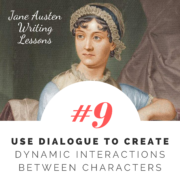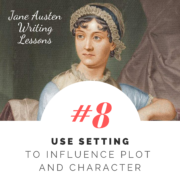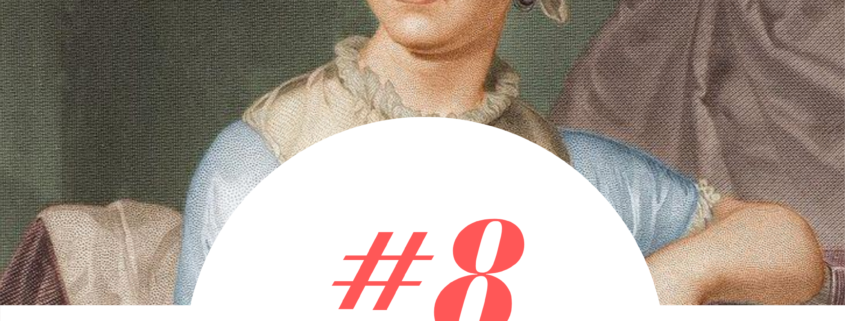Full Sized Blog Element (Big Preview Pic)
#9: Use Dialogue to Create Dynamic Interactions Between Characters
/2 Comments/in Jane Austen Writing Lessons/by Katherine Cowley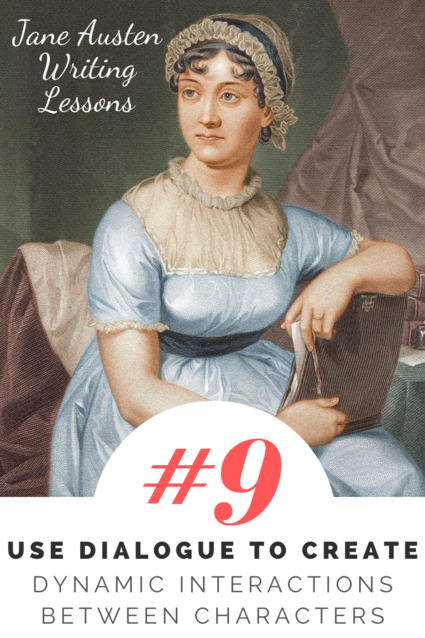
Dialogue is communication. connection. conversation. conflict. character.
Many of the most quoted Jane Austen quotes come from her characters’ dialogue. Personally, I find that the dialogue between her characters is always engaging and dynamic. She never uses it simply for one character to give information to another character (or to the reader): her dialogue always has a deep impact on the plot, on the characters, and on the subtext.
Consider this scene from her first published novel, Sense and Sensibility. The two sisters, Marianne and Elinor, are in London. Marianne is pining for a man named Mr. Willoughby. Many people assume that Marianne is engaged to Willoughby, but Elinor is unsure, and for chapters has not known how to ask her sister for the truth.
A note was just then brought in, and laid on the table.
“For me?” cried Marianne, stepping hastily forward.
“No, ma’am, for my mistress.”
But Marianne, not convinced, took it instantly up.
“It is indeed for Mrs. Jennings; how provoking!”
“You are expecting a letter then?” said Elinor, unable to be longer silent.
“Yes, a little—not much.”
After a short pause, “you have no confidence in me, Marianne.”
“Nay, Elinor, this reproach from you—you who have confidence in no one!”
“Me!” returned Elinor in some confusion; “indeed, Marianne, I have nothing to tell.”
“Nor I,” answered Marianne with energy, “our situations then are alike. We have neither of us any thing to tell; you, because you do not communicate, and I, because I conceal nothing.”
Elinor, distressed by this charge of reserve in herself, which she was not at liberty to do away, knew not how, under such circumstances, to press for greater openness in Marianne.
There are four core components that make this dialogue effective:
What the characters say
How the characters say it
What the characters don’t say
What the characters do
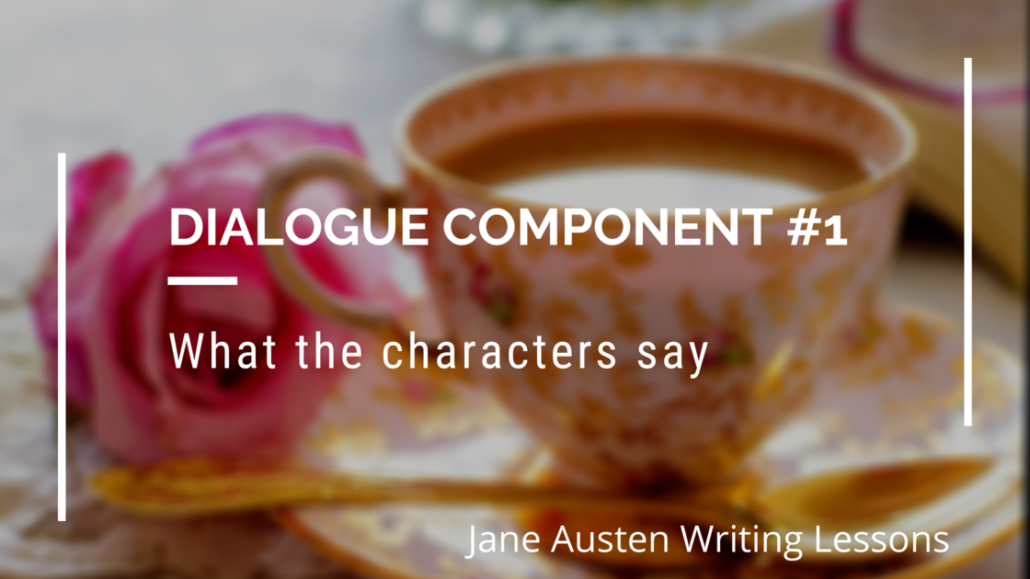
What the characters say
Sometimes two characters will have the same goal or objective for a conversation, but often, characters have different goals.
In this scene, Elinor’s primary goal is to discover the truth from Marianne so she can better help her sister. She takes the opportunity to question Marianne, inviting her to open herself up and confide in her. However, telling Marianne “you have no confidence in me” does not have the intended effect and puts Marianne on the offensive.
Marianne’s original goal is to conceal her anxieties about her relationship with Willoughby: she does not want her older sister’s judgment or advice. To this is added the goal of pointing out Elinor’s hypocrisy. She knows that Elinor, too, is keeping things from her, and while stating this does not lead to Elinor opening up to Marianne, it does achieve Marianne’s ultimate goal of ending the conversation quickly.
When characters have different goals for a conversation, it creates organic and compelling dialogue with forward movement and momentum. (This is true even if the characters have similar goals: character’s goals will never entirely overlap, and this will be reflected in what they say.)
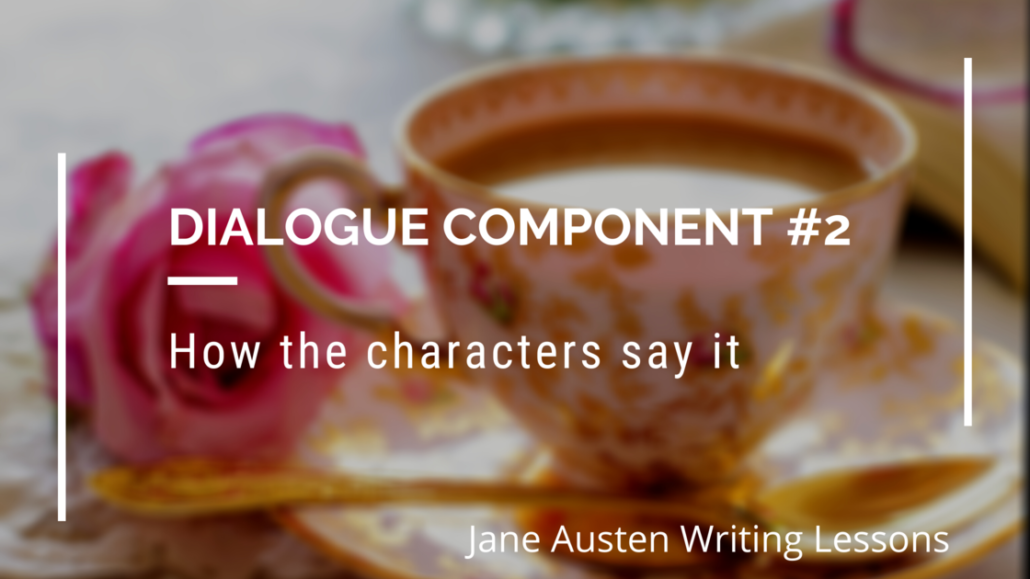
How the characters say it
Most of how the characters are talking, such as their tone and their volume, is implied by the dialogue itself. For instance, the exclamation mark and the sentence structure indicate the way in which Marianne speaks the following line:
“It is indeed for Mrs. Jennings; how provoking!”
Skilled writers like Austen reveal most of how the characters speak by the speech itself, without relying heavily on description. Jane Austen does give several additional descriptions, such as cried Marianne, but if these sorts of qualifiers were used on every line, it would clutter and distract.
In this passage, Austen gives two more brief descriptions of how the characters are speaking: “returned Elinor in some confusion” and “answered Marianne with energy.” These descriptions occur in brief succession, and this contrasting pair paints a portrait of the two sisters, demonstrating even in this short moment how the sisters acts as foils to each other.
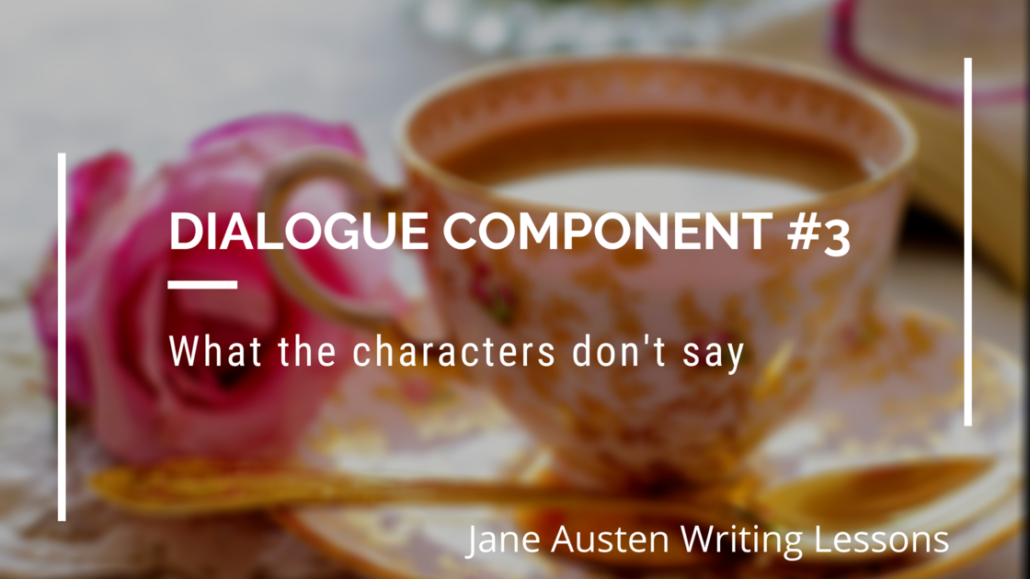
What the characters don’t say
In any conversation, there are a multitude of things left unsaid: motivations and emotions, backstory and baggage. Very few people are entirely open in conversation, even to those who are closest to them. (When characters are finally open with each other, it can create huge emotional resonance for readers.)
What the characters choose not to say has a huge impact on the dialogue. In this scene from Sense and Sensibility, the very subject of the conversation is what they refuse to tell each other. In addition to not talking about their secrets, they do not talk about how irritated they are with each other. This is fueled by their frustration with their situations, and a latent sense of hopelessness, especially for Marianne, but also for Elinor.
Often we see characters’ biggest desires and anxieties in what the characters choose not to say, or find themselves unable to say, and this can help create dynamic interactions.
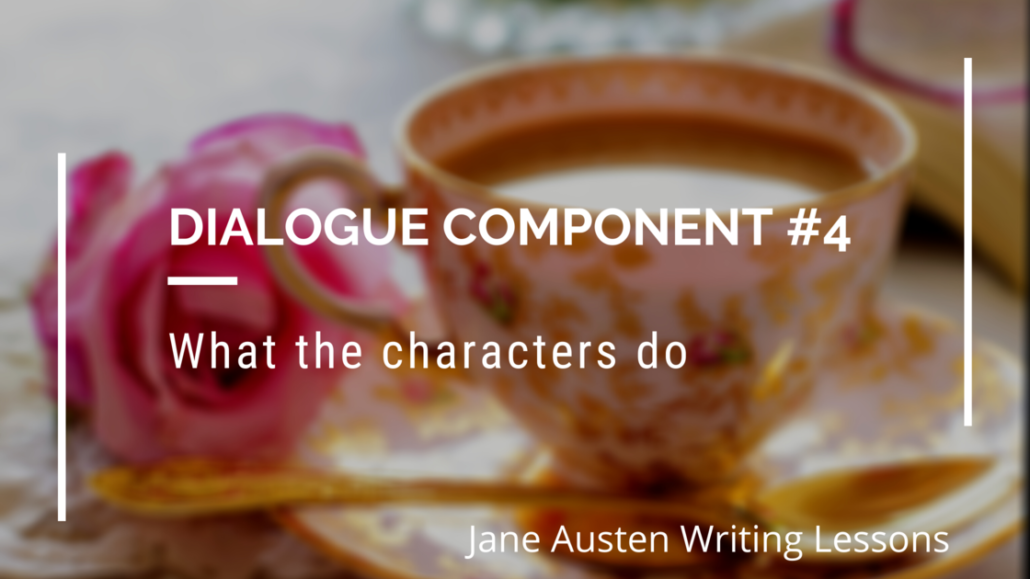
What the characters do
Generally, actions are peppered throughout dialogue scenes, and are just as important as the words that people say.
In this scene, Marianne’s actions betray how much she is hoping for a letter from Willoughby. Her haste in stepping forward underlines her impatience and longing, and she cannot trust the word of the servant—she must pick the letter up herself to see that it is truly not for her.
Inaction can be as important as inaction. Note the power in Elinor’s pause before she makes her accusation:
“You are expecting a letter then?” said Elinor, unable to be longer silent.
“Yes, a little—not much.”
After a short pause, “you have no confidence in me, Marianne.”
This pause provides a space for Elinor to decide to push the subject, and it provides a space for the reader as we watch the characters struggle through this interaction. A different sort of pause comes at the end of the scene when Elinor does not know what to say and we glimpse her internal thoughts.
Dialogue should be used to create dynamic interactions between characters.
In dialogue, writers weave together the said, the unsaid, and action to create character interactions which should be dynamic, or in other words, should possess energy and life. This sort of dialogue is kinetic, in that it creates change and progress (though this be negative progress, moving the characters away from their goals).
Conflict and tension are created by dialogue when the character’s various wants and goals rub up against each other. Connection is created when the dialogue changes the characters’ relationship in a positive way. Ultimately, dialogue is communication, but it is also so much more: it moves the plot forward and provides characters with a way to manifest their personalities and move toward their goals.

Exercise 1: Take a book off your shelf and open it to a random page. Find the first sentence of dialogue on the page and use it as the first line of a conversation you write for brand new characters. Make sure to consider what the characters say, what the characters don’t say, and the actions of the characters.
(There is also a random dialogue generator online that can be used for this exercise.)
Exercise 2:
Write a short passage of dialogue (approximately 3-5 lines/paragraphs), featuring two characters, a girl who wants to buy a lollipop from a candy shop, and a guardian who is trying to save money and wants to get home and rest after a long day.
You will write this passage three different times:
For the first version of the dialogue, have both characters say exactly what they want.
For the second version of the dialogue, have one of the characters say exactly what they want, while the other character does not say what they want, but nevertheless tries to achieve what they want.
For the third version of the dialogue, neither character should say exactly what they want, yet both are trying to achieve their own goals.
In each version of the dialogue, consider how the character is speaking, and what actions they might take, as well as if any pauses would occur.
Exercise 3:
It’s easy to overwrite dialogue and include more than is necessary. Take a scene of dialogue that you have drafted and cut out at least 25% of the spoken sentences (you can cut out individual words too, but as you do so, make sure that you don’t lose your characters’ distinct voices).
#8: Use Setting to Influence Plot and Character
/0 Comments/in Jane Austen Writing Lessons/by Katherine Cowley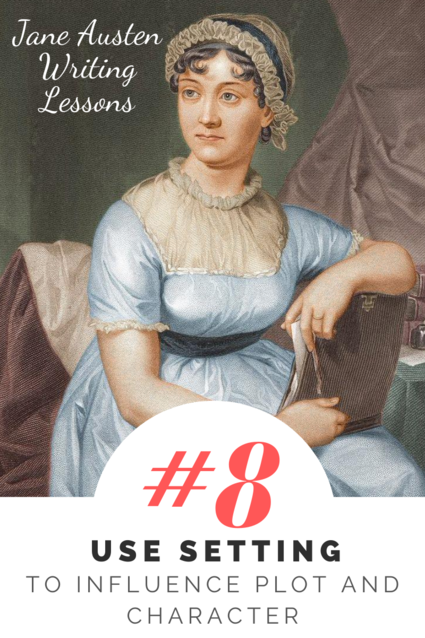
One of the most famous scenes from the book Emma occurs at Box Hill, a hill popular as a sightseeing attraction both in Jane Austen’s time and today. (Sadly, visiting Box Hill is an uncompleted item on my bucket list.)

A view from Box Hill by Benjamin Rusholme (Creative Commons license).
In this scene, Emma’s flaws are brought to the forefront: in an attempt to be clever and keep attention on herself, Emma is cruel to Miss Bates.
“Ladies and gentlemen—I am ordered by Miss Woodhouse to say…that she requires something very entertaining of each of you….[she] demands from each of you either one thing very clever…two things moderately clever[,] or three things very dull indeed, and she engages to laugh heartily at them all.”
“Oh, very well,” exclaimed Miss Bates, “then I need not be uneasy. ‘Three things very dull indeed.’ That will just do for me, you know. I shall be sure to say three dull things as soon as ever I open my mouth, shan’t I—(looking round with the most good-humoured dependence on everybody’s assent)—Do not you all think I shall?”
Emma could not resist.
“Ah! ma’am, but there may be difficulty. Pardon me—but you will be limited as to number—only three at once.”
Miss Bates, deceived by the mock ceremony of her manner, did not immediately catch her meaning; but, when it burst on her, it could not anger, though a slight brush showed that it could pain her.
“Ah!—well—to be sure. Yes, I see what she means, (turning to Mr. Knightley,) and I will try to hold my tongue. I must make myself very disagreeable, or she would not have said such a thing to an old friend.”
This scene’s effectiveness is dependent on its setting for two reasons:
- This setting has brought all of these characters together.
- The setting has created a set of trying circumstances for the characters.
In fiction, the setting of a scene should always be an intentional choice.
In Emma, many of the scenes do occur in Emma’s home, Hartfield. This is very deliberate: in many ways, Emma is trapped by having a hypochondriac as a father (the narrator calls him a “valetudinarian”). Yet there is still a large amount of variability in the settings, even if many of them happen at home or close to home. At seven miles away, Box Hill is the farthest Emma goes from home over the course of the novel, and this is a significant event for the characters, a day planned well in advance.
Setting influences plot. characters.
The choice of the setting should influence both the plot and the characters.
The narrator describes it as a “very fine day for Box Hill,” and everyone commences the seven-mile journey there in good spirits:
Seven miles were travelled in expectation of enjoyment, and every body had a burst of admiration on first arriving; but in the general amount of the day there was deficiency. There was a languor, a want of spirits, a want of union, which could not be got over.
Much of the tension of the scene is caused by contrast between the high expectations for Box Hill and the lack of enjoyment and feeling. Two hours are spent walking around the hill and seeing the sights, yet throughout the entire time, they are plagued by division and separation. In Emma’s opinion, people are behaving in a manner that is “dull” and “insufferable.”
Perhaps it is this struggle with the setting that brings Emma to an internal lowness that invites her to act in an outwardly low manner. (When I am tired, hungry, or overheated, I definitely lose some of my charming personality.)
After her rudeness, the group continues the conversation for a few more minutes but soon breaks apart:
Even Emma grew tired at last of flattery and merriment, and wished herself rather walking quietly about with any of the others, or sitting almost alone, and quite unattended to, in tranquil observation of the beautiful views beneath her.
Yet she does not have the opportunity to enjoy the beauty: in the next sentence, the carriages arrive. In a moment where they are alone, Mr. Knightley reproaches Emma for her behavior.
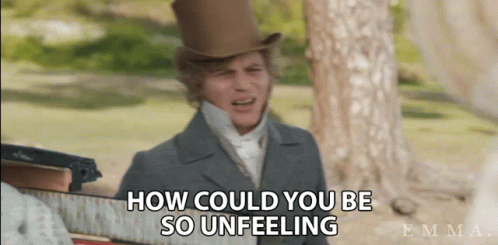
“How Could You Be So Unfeeling?” Knightley reproaches Emma in the 2020 film Emma. (Gif from Tenor.)
After this confrontation by Knightley, which once again occurs in stark contrast to the beautiful surroundings, Emma feels the full weight of guilt. The chapter ends with the following line:
Emma felt the tears running down her cheeks almost all the way home, without being at any trouble to check them, extraordinary as they were.
A well-chosen setting can have a huge influence on the plot and the characters, and the way in which the setting is described provides a lens into the viewpoint character’s thoughts and emotions.

Exercise 1:
Read the following dialogue, which will become part of a short break-up scene:
“I just don’t think it’s going to work out between us,” said Amisha.
“I’m not worried,” said Jesse. “We always get through things.”
“Yes, we could get through this,” said Amisha. “But that’s not what I want. I’m done. Done with this, done with us.”
Now choose two different settings and write two versions of this short scene (two to three paragraphs each). Make sure to not only add description, but also movement and action. Consider what they might be doing in the setting (i.e. cooking dinner in Amisha’s kitchen), how the characters would describe the setting, and how the setting will impact how both the characters and the reader.
Example settings:
- A kitchen
- The beach
- A freeway
- A museum
- A soccer game
Exercise 2:
Choose one of your favorite books or movies, and without rereading or rewatching it, make a list of as many settings as you can from the story. These can be broad settings (i.e. England, the town of Highbury, etc.) or more specific settings (i.e. Mr. Elton’s house, the strawberry patch, etc.).
Once your list is complete, consider the following question: How does the setting impact the plot and the characters in this story?
Exercise 3:
Option 1: Use a scene that you plan to write in a book or short story. Come up with three possible settings that could work well at fulfilling the purposes of the scene. For each setting, list the key attributes of the setting, the advantages of using the setting, and the disadvantages of using the setting.
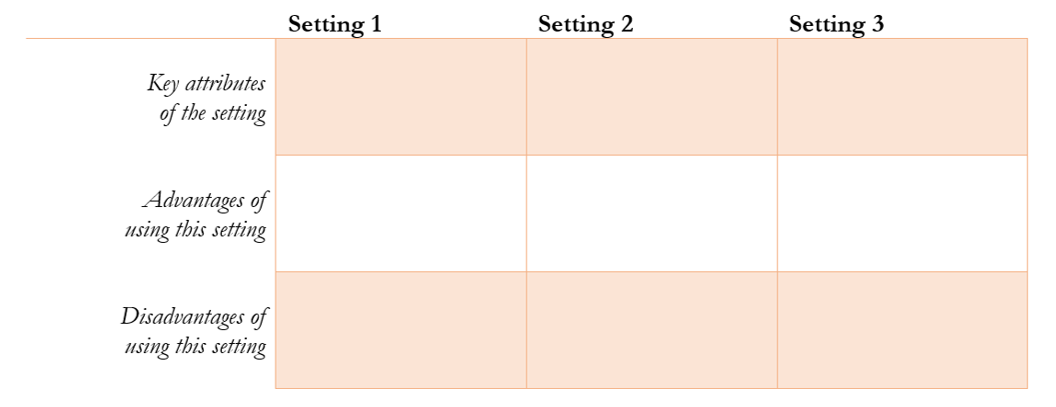
Option 2: Take a scene that you have already written and rewrite it using a new setting. Which do you prefer? What are the advantages and disadvantages of each one?

